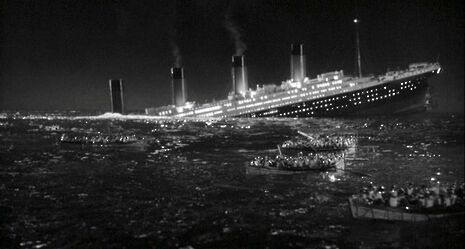Film: The Trouble with Adaptations part 3
From Nazi propaganda to evil sharks and talking mice, Jamie Rycroft discusses different adaptations of the Titanic tragedy

Although I’ve looked in the last two articles at adaptations of works of fiction, this is not to say that other kinds of narrative cannot be ‘adapted’. I believe that storytelling is the backbone of society, although, as an English student, such a platitude obviously appeals to me. Stories help us to sequence random events, explain confusing phenomena, and make sense of things which may be senseless. Nowhere is this more apparent than the adaptation of disaster into tragedy, and whether it’s in depictions of the Greco-Persian wars, or of the 9/11 attacks, people have a desire to see horrific events being accurately (or inaccurately) represented on the silver screen.
Of course, the consequences of adapting a real-life tragedy are far graver than adapting a fictional one. The biggest ‘trouble’ with adapting a work of fiction is that fans may be angered by an unfaithful interpretation. The writer of an adaptation of history, meanwhile, is attempting to depict real people who lived and died. The sinking of the RMS Titanic in 1912 quickly seeped into the public consciousness as a legendary catastrophe, and cinematic depictions of the disaster are almost as old as cinema itself. But unlike many other disastrous historical events, the Titanic tragedy has no antagonist. Many figures, like J. Bruce Ismay (the chairman of White Star Line) or Thomas Andrews (the ship’s architect), are blamed for certain factors which caused many to die, like there not being enough lifeboats. But, for the most part, the truth is that there was no ‘villain’ that caused the Titanic to sink, but instead a combination of bad luck and bureaucracy. The lack of lifeboats, for instance, was due to outdated laws which recommended a maximum of 16 lifeboats regardless of the number of people actually on board. Bad legislation, however, does not make for good cinema, and many of the huge number of movie adaptations that exist of the Titanic disaster try to reduce complex events to a narrative closer to that of a story, in an attempt to make it more understandable.
What one might not expect, however, is for this story to be used to further political agendas. In fact, the first Titanic adaptation to blend factual and fictional characters was a Nazi propaganda movie from 1943, which paints Ismay as a greedy capitalist who caused the ship to crash by attempting to break the water speed record (a popular myth created by the media shortly after the accident). Commissioned by Joseph Goebbels, the movie had a limited run in Paris and Prague, but was banned from being played in Germany. This is likely because the depictions of suffering and panic hit a little too close to home for citizens suffering from raids by the Allied forces, but there also appears to be an anti-authoritarian streak within the movie which rails against Nazis as well as the British. The ‘hero’ of this story is the only German on board, the fictional first officer Peterson, whose warnings that the ship is heading towards a drift ice zone are ignored by an inept captain. Surprisingly, however, the story is not made as pro-German as one would expect, with the failure of communication being instead caused by the absurdity of having people with specific nautical skills oppressed by those with no knowledge in the field whatsoever. Such an attitude would work well in Communist propaganda, but it does not succeed in promoting a system which suffered from almost identical problems. The constant prevalence of an agenda, whatever it is, interrupts the plot, resulting in a film which doesn’t know whether to focus on Peterson’s struggle, on Ismay’s greed, on a love story between two passengers, or on any other plot thread. The outcome is a movie which is independent enough from Nazi values to be watched without guilt, but which is too concerned with furthering its ideology to tell a cohesive or compelling story.
The ‘Nazi Titanic’ was surprisingly influential on future adaptations of the tale, and many of its elements, including its fictional love story, contrast between first- and third-class passengers, and necessity for a human villain, appear in the monolithic 1997 version directed by James Cameron. This Titanic was clearly made in a time when people had little to worry about, and audiences wouldn’t feel perturbed watching a film which unashamedly mixes unimaginable violence with a sugary romantic subplot. Characterisation is achieved in almost insultingly broad strokes. It’s not enough for Jack and Rose, the central couple, to be nice people; they must also hold impossibly modern values, in everything from art to society. It also propagates many of the myths from the 1943 version, though not in as explicit a manner. References are also made to the ship being forced to go faster, and to third-class passengers being locked beneath the deck (third-class passengers were kept separate from others, but for reasons of infection rather than classism). Nonetheless, the film’s intentional and unintentional inaccuracies cannot obscure its strengths. Kate Winslet and Leonardo DiCaprio are naturally charming actors, even when the script forces them to deliver petulant lines. The modern segments which explore the wreckage of the ship are fascinating and show a deep passion for the subject matter. Cameron’s prestige as an action movie director is displayed throughout the climax as he crafts wonderfully tense set-pieces. It’s a fantastic disaster movie, but as a movie about a real tragedy it feels queasily sentimental. It’s hard, however, not to fall for this adaptation’s allure. The endlessly parodied scene where Jack draws Rose like one of his "French girls", other than providing some soft-core nudity, serves little purpose to the plot. Yet this small moment, where reality is romanticised through its transformation into artwork, is an apt summary of the way in which this adaptation softens much of the event's reality, in a manner which should be offensive but cannot help but captivate most viewers.
Since it was, for a long time, the highest-grossing movie ever made, the 1997 Titanic has cast a long shadow across cultural awareness of the tragedy. One of the more blatant rip-offs is The Legend of the Titanic, an animated kids’ movie made two years later. Quite why anyone thought that an event in which over 1,500 people died needed an adaptation for children is anyone’s guess. A possibility that I believe, or that I feel most comfortable believing, is that everyone involved in the film’s production had watched Cameron’s Titanic and not quite realised that it was based on real events. This is because Legend of the Titanic is probably the most insulting adaptations of a non-fiction tragedy ever made, pushing Cameron’s idealism to its most disturbing extreme. It has a love triangle identical to the 1997 version, but the villainous character is turned into an evil whaler who sinks the ship so that he can hunt wherever he wants. He achieves this by communicating with a gang of sharks, who convince a naïve octopus to throw an iceberg at the ship. I am not making this up. Rather than mix historical with fictional characters, there is not a single person in this movie with a tangibly real counterpart. Cameron’s Titanic had the elements of a fairytale, but this version is literally a ‘legend’, with an evil stepmother, eye patch-wearing villain, and talking mice. As horrifically misguided as this adaptation is, it intriguingly exposes tendencies present in many other versions. The Legend of the Titanic is most clearly based on myth rather than history, yet like the other two movies it expresses a need to create a political motive to the tragedy, and to pin its occurrence down to "an evil human being".
We saw with Wuthering Heights how adaptations can struggle to fully explore the original narrative, and with The Great Gatsby how adaptations can emphasise (and perhaps even improve upon) dimensions latent within the source work. With Titanic we have something quite different: an attempt to bury and censor certain elements of a story, whilst fabricating others. I’ve repeatedly compared adaptations of the sinking of the Titanic with my own personal narrative, one where, tragic as it is, the disaster was a random natural occurrence with no one entirely to blame. Yet my narrative is as much of a fabrication, a fiction, as any other, and though some parts might have more factual basis than others, any understanding of history must choose certain ideas over others and thus create some kind of bias. What I hope I’ve partly done throughout this column is show that our current obsession with adaptations being ‘inferior’ to the original is perhaps not a healthy one, as it denigrates the need for copying and transformation so integral to culture. Adaptations can be troublesome, but each one adds something to the way in which we tell stories, no matter what that story is.
 Comment / Anti-trans societies won’t make women safer14 November 2025
Comment / Anti-trans societies won’t make women safer14 November 2025 News / Controversial women’s society receives over £13,000 in donations14 November 2025
News / Controversial women’s society receives over £13,000 in donations14 November 2025 News / John’s rakes in £110k in movie moolah14 November 2025
News / John’s rakes in £110k in movie moolah14 November 2025 Fashion / You smell really boring 13 November 2025
Fashion / You smell really boring 13 November 2025 Music / Three underated evensongs you need to visit14 November 2025
Music / Three underated evensongs you need to visit14 November 2025









